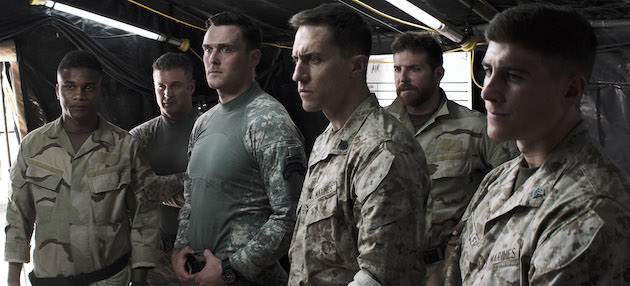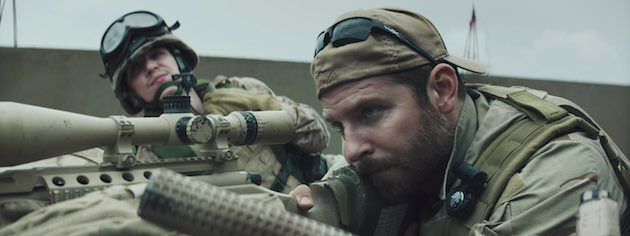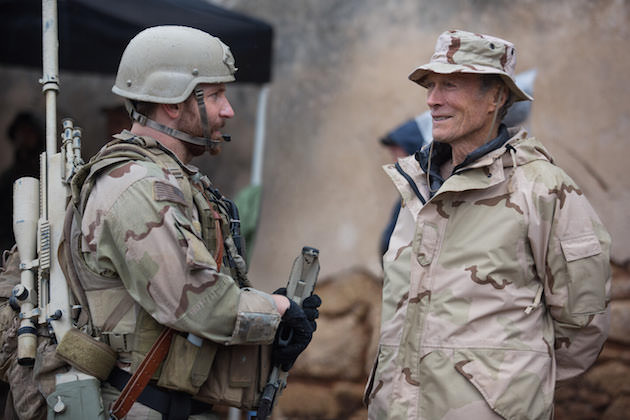A Q&A with James Dever, Military Advisor on American Sniper
James Dever was just following orders. In 1986, Clint Eastwood arrived at Camp Pendleton, the Southern California Marine Corps base, to direct, and star in, Heartbreak Ridge. Dever, a gunnery sergeant with more than 13 years in the Corps under his belt at the time, was assigned by his Colonel to work with Eastwood — whose character, Thomas Highway, is also a gunnery sergeant.
The experience proved intoxicating. “I said to myself, this is something I want to do when I retire form the Corps,” says Dever. Twelve years later, having reached the rank of Sergeant Major, Dever hung up his stripes for good and jumped into a new career as a military advisor to film and TV.
His services have been in steady demand ever since. Known for his historical knowledge and attention to detail, Dever and his company 1 Force Inc., have served on more than 41 feature films, including Eastwood’s remarkable World War II bookends, Flags of our Fathers and Letters from Iwo Jima.
Having helped oversee the evacuation of Saigon in 1975 and participated in Operations Desert Shield, Desert Storm, and Desert Saber (Persian Gulf War), Dever has a remarkable resume to draw on. His skills include weapons handling, Close Quarters Combat, NAVY Seals tactics, and high altitude parachuting, among many others.
On American Sniper, Dever coached Bradley Cooper as NAVY Seal Chris Kyle, and worked with former Marines as well as actors to bring a level of authenticity to the screen that has drawn raves. Now, as the film is set to open nationwide on January 16, including a just-announced spectacular IMAX version, Dever talks to The Credits about his respect for Eastwood, his role on Sniper, and the preparations he goes through prior to a job.
Let’s go back to that serendipitous moment of being assigned to work with Clint Eastwood on Heartbreak Ridge. What were your duties?
My job was to make sure the Marines in the shoot showed up every day depending on how many they needed and to do recon. My duties included things like making sure the repel tower was ready—I tied all the ropes and had my Marines test them out before the actors used them. I made sure the uniforms were right and answered any questions Clint had. That’s when I thought ‘this is something I’d like to do when I retire.’ Once I did, I started making phone calls and I hooked up with Forest Whittaker on an independent movie called The Green Dragon, which was about Vietnamese refugees after the fall of Saigon who were housed at Camp Pendleton.
You got on a roll from there . . .
Yeah. I next talked to John Woo and worked on Windtalkers and after that I started to read a lot about historical events and hooked up with Edward Zwick on The Last Samurai. I’m a big fan of history and that was based on Civil War tactics. In fact, I’m reading up on the Civil War right now based on my own interest and because I’m looking for a Civil War movie to work on. Like anything else I study and read books for details and research to make sure everything is correct on set.
How do you describe your job?
I’m an adviser. I work with the art director and assistant directors, with the stunt coordinator, the actors, and wardrobe. And of course, the director. I can tell them the right way to do things, the wrong way, and the director's way. What I mean by that is, sometimes if you try to do things the real way, it might not look good on camera. You want everything look as real as possible but you have to take artistic license at times.
Tell me about your role on American Sniper, in particular about sniper school with the actors?
We were in California for that, on the Paramount Ranch. First we had to show the art department how to set up and build a firing range — we had to have a platform for the snipers to fire from, the flags at the end of the range to let you know about the wind, what kind of targets we were going to use and a berm so special effects can set up the hits and misses where the rounds would be impacting. I also worked with the props department for the weapons they would be using. In that section alone we only used the Mark 12 with a suppressor (silencer) and non-suppressor to make it easier for that shot. The Mark 11 is also a sniper rifle, but we wanted to keep it simple with all the same ammunition on the weapons.

And about training Bradley Cooper?
We had to get him familiar with the sniper rack — we were using live ammo and he got familiar with the rifle itself, the WinMag 300, plus the Mark 12 and 11, and M4 and the SIG pistol. He was awesome. He really gets into it — physically, mentally, everything. He listens and he trains and he makes sure he gets it right. We were doing roof clearing and he was taking shots at 600 yards and hitting steel plates — 8-inch and 12-inch plates. We took him through the pistol, the M4, and physically moving and shooting. He would make a great Marine or Navy Seal.

Did the training continue on location in Morocco?
Yes. We had the actors from California and then my guys were also training the Moroccans to be Marines. We taught them how to move and carry weapons, some CBT — Close Quarter Tactics — to use when entering a room, and how to cover each other while moving through an urban environment. And also how to drive a Humvee. You don’t just jump in and start driving — they’re tight fitting and you also have your combat equipment on so it’s really restricting. But you get used to it.
American Sniper is your fourth Eastwood film. What’s it like to work with him?
It’s amazing. The first time I met him he was about 56 years old. He's 84 now and he hasn’t changed. He’s in great shape — we were in Morocco and there was a gym we went to and he was right there. Working with him is hard work but enjoyable. He hires people to do their job. He doesn't micromanage. We were in Iceland for Flags of our Fathers, on the beach, and he says, we're going to have two cameras set up here, and we’re going to have the Marines come in from the beach. And that's all he mentioned. He left myself, props, set deck, special effects, the stunt coordinator, and we got together and set up the whole beach. And then he shows up and says, let's shoot. He's respectful of everybody's job and knowledge.

You also worked on Unbroken. What was your role on that one?
I didn't get to go to Australia. I did all the research for the art department and wardrobe and any questions they had about the Japanese and the camps. And I advised them about the B24 Bombers they built for the shoot. I have all the original maintenance manuals for those and on set, the art department didn't know that the bomb bay doors roll up, not out, like on a B17 Bomber and I had to scan a lot of my photos to show them.
Your library sounds amazing.
I have Japanese books that go back to the World War II period and the Samurai. I love the Japanese military books. I have German books about uniforms and equipment and the Civil War, too. I have the World War II flying books about the rigs and jets. Every movie I do, I always study. Even on Godzilla. I’m working with the Navy, and the Air Force, and the Army. Being in the military for 25 years, it’s a lot easier for understanding tactics and things like that. You pick it up a lot quicker.
What kinds of mementoes do you have it that library?
I have World War II weapons. I have Samurai swords. Black powder pistols. Plus, I have a place that I can go— a prop house — where I can familiarize myself with weapons from different time periods.
What’s your next project?
There’s another good war movie coming out that I’m looking at called Hacksaw Ridge. Mel Gibson is going to direct it. It about the Battle of Okinawa. I also work regularly on Persons of Interest on CBS. I work on stunts. I did one recently where I started fighting with Jim Cazievel on a 100-year-old carousel. He beats me up, but that’s fine.
What would you say is the biggest misconception movie audiences have about war?
I don't know the biggest one. But it’s not all glory like the Rambo movies. People are dying, even your friends. But you continue doing your job — you can’t yell cut! In real life the battle continues until you defeat the enemy or move the enemy out of the area.


